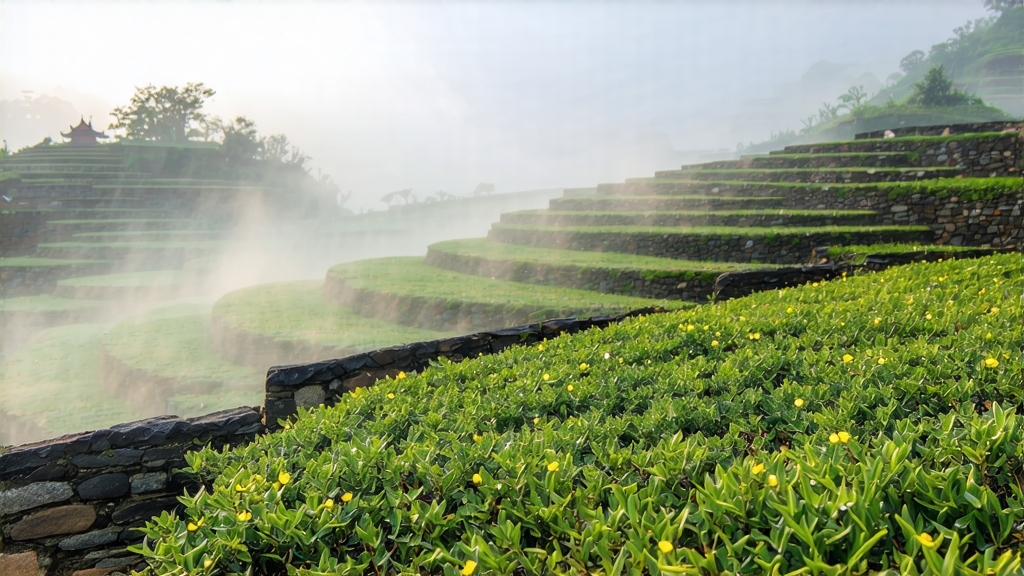
Tucked high on the mist-laced ridges of Mengding Mountain in Sichuan Province, Mengding Huangya has been quietly shaping the soul of Chinese yellow tea for more than twelve centuries. To most overseas drinkers “yellow tea” sounds like a mis-labelled oolong, yet this bud-only rarity occupies its own narrow lane between green and dark teas, a lane paved with imperial edicts, poetic dynastic odes, and a vanishing micro-craft called “sealed yellowing” that turns spring’s emerald tips into liquid topaz. The following portrait follows Mengding Huangya from its myth-shrouded birth to the exact moment it slips across a taster’s palate, offering the reader every practical tool needed to brew, evaluate, and above all appreciate a tea that even within China is now seen only in small, covetable lots.
-
A leaf born of legend
Buddhist monks on Mengding claim that the first seven tea bushes were planted in 53 BCE by Wu Lizhen, a cultivator-sage who later became the mountain’s patron immortal. By the Tang dynasty (618-907) the bushes—still alive today and fenced off as “royal mother plants”—were taxed in tribute, and Song emperors so prized the honey-coloured liquor that they exempted the monks from land tax in exchange for 400 grams of early-spring buds. When the Ming court moved its capital north, the tea travelled in silk-wrapped caskets along the same courier roads as Sichuan pepper and medicinal rhubarb, gaining the name Huangya, “yellow bud,” because the finished leaf showed a brilliant straw-gold against the green of contemporary tribute teas. What the emperors did not know was that the colour came from a slow oxidation step unknown to green-tea makers, a step that would later define the entire yellow tea family. -
Micro-terroir on the roof of Sichuan
Mengding Mountain, 1,450 m above sea level, rises through three climate belts in less than 20 km. Morning clouds roll up the Min River valley, stall against the cliff face, and condense into a 85–90 % humidity blanket that lingers until noon. The soil is a loose, slightly acidic purple sandstone rich in selenium and zirconium, minerals that tighten the cell walls and force the plant to stockpile theanine. Because the mountain lies at the southern edge of the Sichuan basin, winter frost is brief, allowing the tea plant—here the small-leaf landrace Camellia sinensis var. sinensis ‘Mengding #9’—to flush two weeks earlier than Hangzhou’s Longjing. The combination of high altitude UV, mineral soil, and protracted mist produces buds that are shorter and stouter than those of Jiangnan greens, with a downy silver reverse that looks almost white under magnification. -
Plucking by the old lunar rule
Modern factories speak of “one bud and one leaf,” but the Mengding monks still follow the Qing-era dictate: “pick when the morning star fades, stop when the dew no longer beads.” Work begins at 5:30 a.m. on the first three days after Qingming festival, when the bud has reached 15–20 mm but the first leaf is still folded like a paper fan. Each picker carries a bamboo ganlan basket lined with fresh banana leaf; the leaf prevents compression bruising and adds a faint grassy note that later harmonises with the yellowing aroma. A seasoned plucker gathers barely 400 g of fresh buds in four hours—enough for 100 g of finished tea—so a single 500 g imperial tin once required the dawn labour of twenty villagers. -
The five breaths of sealed yellowing
Yellow tea’s identity rests on a unique micro-fermentation that occurs after kill-green but before final drying. Mengding masters call this men huang, “sealed yellowing,” and divide it into five discrete breaths:
First breath – shaqing (kill-green): 180 °C bamboo-roasted wok, 4 min, 200 g buds per batch, hand-tossed 48 times to lock in a grassy core.
Second breath – re-men (hot wrap): buds piled at 55 °C inside a hemp cloth for 40 min; chlorophyll begins to break down, releasing pyrazines that give the later nutty note.
Third breath – tan liang (cool spread): the pile is opened on a rattan tray for 20 min, dropping temperature to 35 °